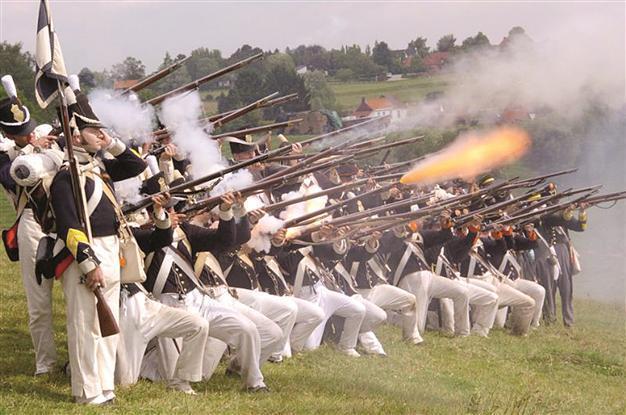Culinary Myths and Battlefields
Aylin Öney Tan - aylinoneytan@yahoo.com
 He slept at a folded military camp bed, even in times of peace. He never slept long any way; he even considered spending time in bed as a waste (except for reasons other than sleeping, but that is another story) and always woke up at daybreak. Considering that he led some 60 battles, there is no wonder that his campaign bed was his comfort zone.
He slept at a folded military camp bed, even in times of peace. He never slept long any way; he even considered spending time in bed as a waste (except for reasons other than sleeping, but that is another story) and always woke up at daybreak. Considering that he led some 60 battles, there is no wonder that his campaign bed was his comfort zone. I cannot help remembering the Duke of Wellington as I step into the Brussels airport to visit the region of Wallonia for the commemoration of the Battle of Waterloo. We will be watching the reenactment of the batlle as part of the Ski Club of International Journalists (SCIJ) group summer meeting. Poppies, symbols of martyrdom, hang along the walkway; a long corridor leading to the passport line is flanked with scenes from the Flanders Fields of World War I. Europe and Belgium are remembering two devastating wars of their past: the bicentennial of the Napoleonic Wars, its commemoration intertwined with the remembrance of World War I, which happened a century later.
Arthur Wellesley, titled as the 1st Duke of Wellington, is inevitably the foremost historic figure to recall, along with Napoleon, when remembering the campaign of Waterloo. He is the great commander of the Anglo-allied forces that defeated Napoleon in Waterloo, now in the Wallonia region of Belgium. Wellesley was a man of endurance. He would expect his army to rise very early while still dark and start marching at daybreak. He himself usually ate only twice a day, breakfast and dinner, and was content sustaining on cold meat and bread. He surely denied comforts of life, stayed attached to his campaign bed at warzone even in peacetime, but had a weak spot for quality wine; whenever possible, he enjoyed a whole bottle of good wine to accompany his humble cold cuts of meat and plain bread. In the case of battle of Salamanca in southern Spain, just before starting the final battle, he was said to be chewing on a cold chicken leg, undistractedly observing the French army through his spyglass. Spotting a weak spot in the left flank of the army, he is said to have thrown the chicken leg in the air, shouting “Les français sont perdus!” (“The French are lost!”), and began the final maneuver.
Noble Beef vs Cold Meat
It is interesting that a noble dish like Beef Wellington, is believed to be named after Duke Wellington, a man of humble cold meat lunches, but that might just be one of the myths of culinary history. According to the infamous connection, the French dish filet de bœuf en croûte (fillet of beef baked in pastry) was already a part of British cuisine, and according to Leah Hyslop of daily Telegraph, an elaborate version was renamed after the Duke, as an act of “timely patriotic rebranding of a trendy continental dish.” Other acquaintances of the dish go as far as New Zealand’s Wellington, but we all like to believe that the mushroom duxelles and pâté covered rare roasted meat encased in flaky mille-feuille crust is connected to a heroic man, even if it is just a myth. In reality, the cooks of Duke of Wellington are said to have quit, because of the Duke’s total indifference to their food. It was a waste of their talents to toil in creating dishes for his honor, a man so uninterested in culinary pleasures. An original Beef Wellington itself is a heroic dish for chefs, as it is a true challenge to achieve a perfectly made one. It must be the benchmark for culinary students, who nowadays want to become Picassos without drafting a good sketch and jump into the world of beautiful-to-look-at tweezers plated dishes of today, without crafting a single perfectly cooked beef Wellington.
Bloody Myth
While the real story of the French dish remains to be solved, there is another culinary story related to British army heroes. If there is a cocktail to celebrate the Napoleonic Wars, it has to be Nelson’s Blood. The cocktail is named after a major British commander, Lord Nelson, another hero of Napoleonic Wars, a master of strategy with unconventional military tactics that resulted in quite a number of naval victories. As Duke Wellington’s body was transferred to London by train after his death (despite the fact that he hated rail travel), Nelson’s last voyage was to be quite different: Pickled in Navy rum. After he was shot dead during his final victory at the Battle of Trafalgar in 1805, his body had to be returned to London in a way so that it would be preserved unspoiled. They decided to put him in a cask filled with rum. Upon arrival, the cask was found drained of the rum and only with the body of Nelson in “pickled” condition. The disputed theory is that the ship’s sailors opened a hole in the cask with a drill to suck up all the rum and since then, the term “tapping the admiral” has become an expression in the Royal Army given to the practice of sucking liquor from a cask with straw. Furthermore, there is cocktail based on this rumor named “Nelson’s Blood.” The story is hard to believe but as many other culinary myths, it is good bar talk, thanks to the great drinkers who probably created the story with their pickled brains in a highly intoxicated state!












